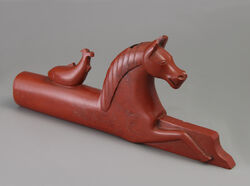A horse and a fish
January 2023

The horse is of great importance to the Indians, for the status of a person and tribe, but also for hunting, for example the bison. It is therefore not surprising that the horse is often depicted. The so-called flying horse, also called running horse, is a favorite. It is a stylized animal with the front legs stretched far forward, the head and mane are shown in a smooth design. When it comes to a tobacco pipe, the pipe bowl is placed in the neck and head of the animal, the front legs then protrude along the elongated stem that characterizes the peace pipe. The horse motif has dominated Sioux art for over a century when another animal comes in as a motif around 1900, namely the fish. That animal has no traditional relationship with these Indian peoples, the depiction of the fish is mainly regarded as a highly marketable representation. From the moment the Indians have to live on reservations, they make their decorated utensils mainly for trade and then the image of a fish quickly proves popular. This pipe bowl shows a combination of both animals. The flying horse dominates the pipe design, but a fish in an almost acrobatic pose can be seen very playfully on its back. If you examine the surface of the object, you can clearly see traces of metal tools, which confirms the relatively recent dating as native reservation art. The pipe is made by a sub-tribe of the Sioux namely the Nakota, also referred to as Yankton Sioux. All in all, this is an image that sold well, especially because of the striking color of the unreal red pipe stone from Minnesota, better known to us as catlinite, which is sacred to the Indians.
Amsterdam Pipe Museum APM 24.600
Archive object of month